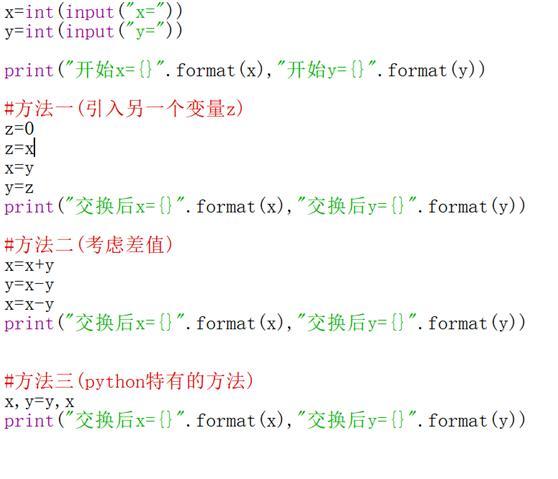大家好,小编来为大家解答以下问题,python里两个等号代表什么 python中连续两个小于号,现在让我们一起来看看吧!

100个Python代码大全:提升编程效率的实用示例
Python是一种广泛使用的高级编程语言,以其简洁优雅、易于学习和强大的库而闻名PHP自动翻译:技术革新与语言障碍的较量。无论你是一位经验丰富的程序员还是初学者,都可以从这种语言的丰富资源中受益。在本篇博客中,我将分享100个实用的Python代码示例,旨在帮助你掌握Python编程,并在日常工作中提高效率。
基础
Hello World - 最基本的程序。
print("Hello, World!")
变量赋值 - 创建并赋值变量。
x = 10
y = "Python"
数据类型 - 演示Python中的基础数据类型。
integer = 1
floating_point = 1.0
string = "text"
boolean = True
条件语句 - 使用if-else结构。
if x > 10:
print("Greater than 10")
else:
print("Less than or equal to 10")
循环结构 - for循环遍历列表。
for item in [1, 2, 3, 4, 5]:
print(item)
函数定义 - 创建一个打印问候语的函数。
def greet(name):
print(f"Hello, {
name}!")
类定义 - 定义一个简单的Python类。
class Greeter:
def __init__(self, name):
= name
def greet(self):
print(f"Hello, {
}!")
列表推导式 - 快速生成列表。
squares = [i * i for i in range(10)]
字典操作 - 简单的字典使用示例。
person = {
"name": "Alice", "age": 25}
person['age'] = 26 # 更新
文件读写 - 打开并读取文件内容。
with open('', 'r') as file:
content = ()
数据处理
CSV文件读写 - 使用csv模块处理CSV文件。
import csv
# 写入CSV
with open('', 'w', newline='') as file:
writer = csv.writer(file)
writer.writerow(["name", "age"])
writer.writerow(["Alice", 30])
# 读取CSV
with open('', mode='r') as file:
csv_reader = csv.reader(file)
for row in csv_reader:
print(row)
JSON数据处理 - 序列化与反序列化JSON。
import json
# 序列化
data = {
"name": "John", "age": 30}
json_data = json.dumps(data)
# 反序列化
parsed_data = json.loads(json_data)
Pandas数据分析 - 使用Pandas进行基本的数据操作。
import pandas as pd
df = pd.DataFrame({
'A': [1, 2, 3], 'B': [4, 5, 6]})
print(())
NumPy数组操作 - 使用NumPy进行科学运算。
import numpy as np
arr = np.array([1, 2, 3])
print(arr + 1)
数据可视化 -使用Matplotlib进行基本的数据可视化。
import matplotlib.pyplot as plt
# 生成数据
x = range(10)
y = [xi*2 for xi in x]
# 绘制图形
(x, y)
plt.xlabel('X Axis')
plt.ylabel('Y Axis')
plt.title('Simple Plot')
()
文件和目录操作
列出目录内容 - 打印指定目录下的所有文件和文件夹名。
import os
path = '.'
files_and_dirs = os.listdir(path) # 获取当前目录中的文件和子目录列表
print(files_and_dirs)
创建目录 - 如果不存在,则创建新目录。
if not .exists('new_directory'):
os.makedirs('new_directory')
文件存在检查 - 检查文件是否存在于某路径。
file_path = ''
if .isfile(file_path):
print(f"The file {
file_path} exists.")
else:
print(f"The file {
file_path} does not exist.")
拷贝文件 - 使用shutil模块拷贝文件。
import shutil
source = ''
destination = ''
shutil.copyfile(source, destination)
删除文件 - 删除指定路径的文件。
try:
os.remove('')
except FileNotFoundError:
print("The file does not exist.")
网络编程
HTTP请求 - 使用requests库发起HTTP GET请求。
import requests
response = ('')
print(response.status_code)
下载文件 - 从网络上下载文件并保存到本地。
import requests
url = ''
r = (url)
with open('', 'wb') as f:
f.write(r.content)
Flask Web应用 - 创建一个简单的Web服务器。
from flask import Flask
app = Flask(__name__)
@app.route('/')
def home():
return "Welcome to my web app!"
if __name__ == '__main__':
(debug=True)
发送邮件 - 使用smtplib发送电子邮件。
import smtplib
from import MIMEText
smtp_server = ""
port = 587 # For starttls
sender_email = ""
receiver_email = ""
password = input("Type your password and press enter: ")
message = MIMEText("This is the body of the email")
message['Subject'] = "Python Email Test"
message['From'] = sender_email
message['To'] = receiver_email
# Create a secure SSL context
context = ssl.create_default_context()
with (smtp_server, port) as server:
server.starttls(context=context)
server.login(sender_email, password)
server.sendmail(sender_email, receiver_email, message.as_string())
WebSocket客户端 - 使用websocket-client库连接WebSocket服务器。
from websocket import create_connection
ws = create_connection("")
print("Sending 'Hello, World'...")
("Hello, World")
print("Sent")
print("Receiving...")
result = ()
print("Received '%s'" % result)
ws.close()
文本处理和正则表达式
字符串拼接 - 连接多个字符串。
first_name = "John"
last_name = "Doe"
full_name = first_name + " " + last_name
print(full_name)
字符串分割 - 使用分隔符或空格分割字符串。
text = "apple,banana,cherry"
words = text.split(',')
print(words)
大小写转换 - 转换字符串的大小写。
message = "Python is Awesome!"
print(message.lower())
print(message.upper())
字符串替换 - 替换字符串中的子串。
greeting = "Hello World!"
new_greeting = greeting.replace("World", "Python")
print(new_greeting)
正则表达式匹配 - 使用re
原文地址1:https://blog.csdn.net/penggerhe/article/details/135359596
python手册 http://www.78tp.com/python/





















 1万+
1万+

 被折叠的 条评论
为什么被折叠?
被折叠的 条评论
为什么被折叠?








